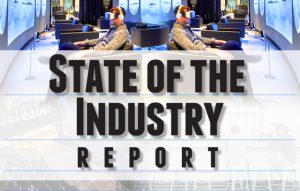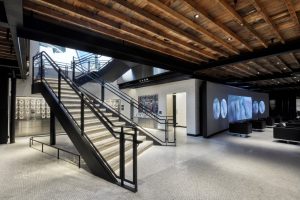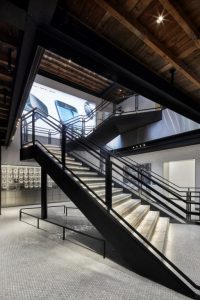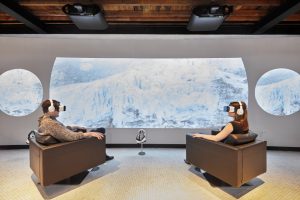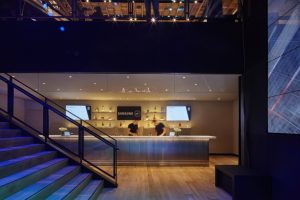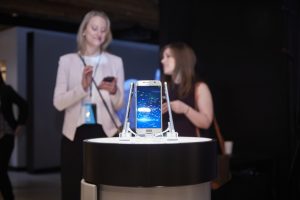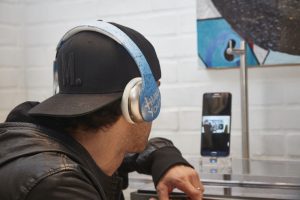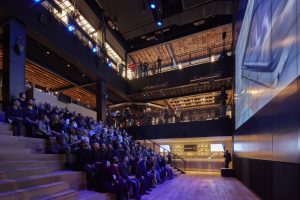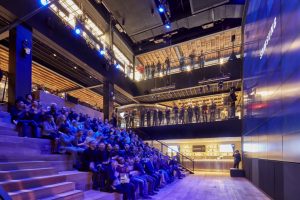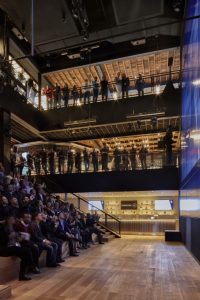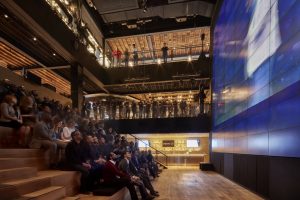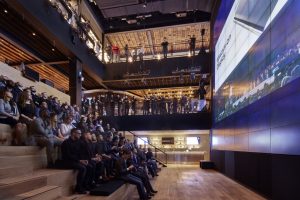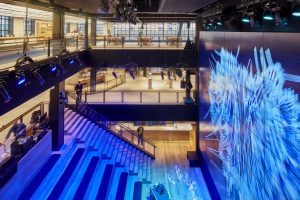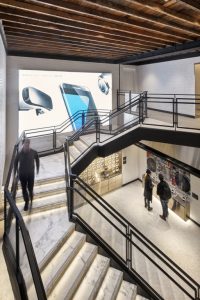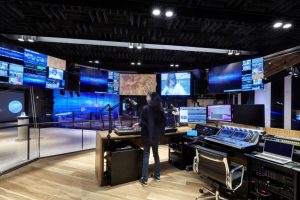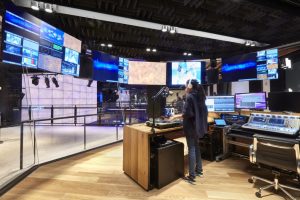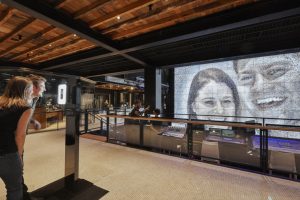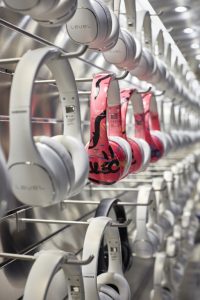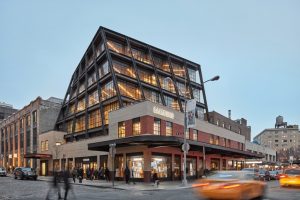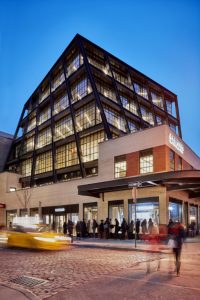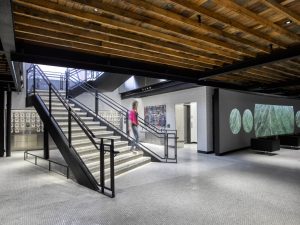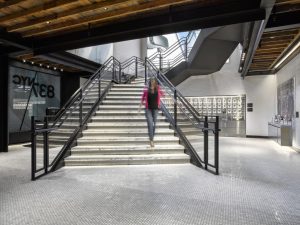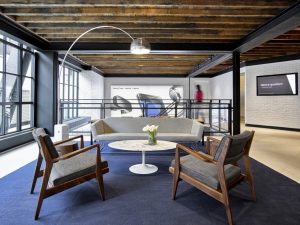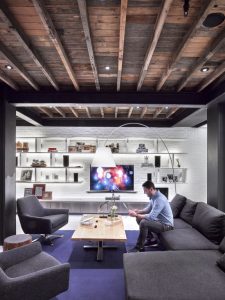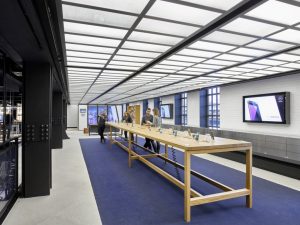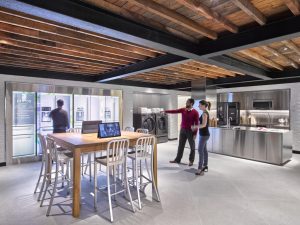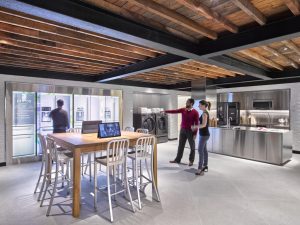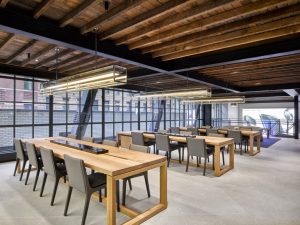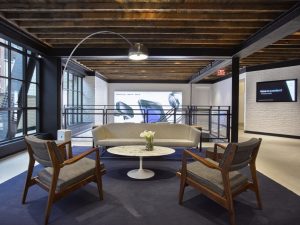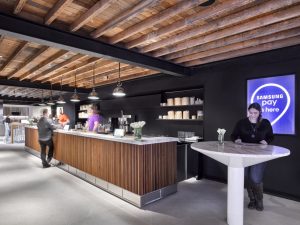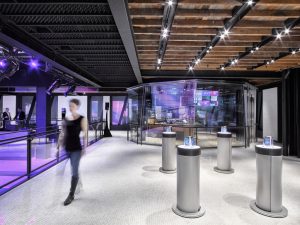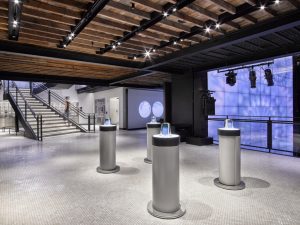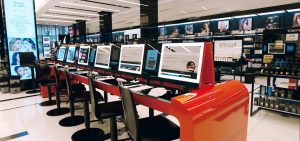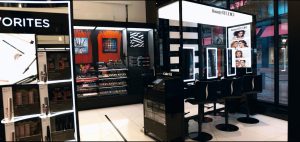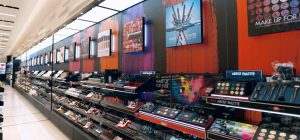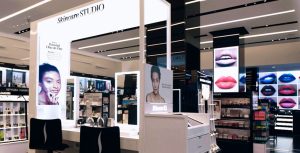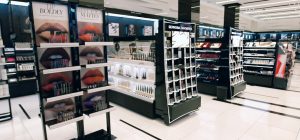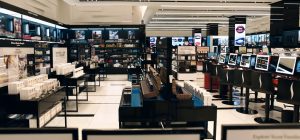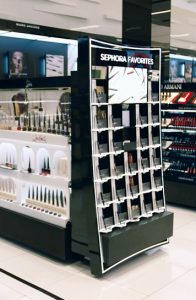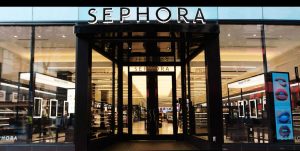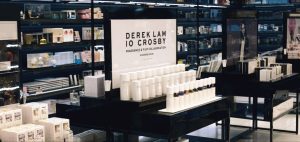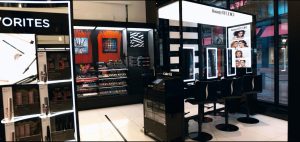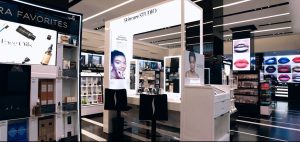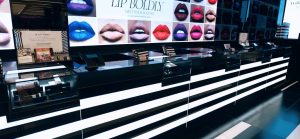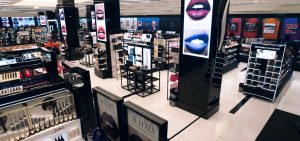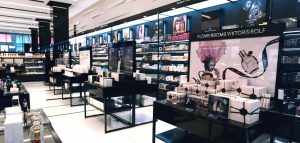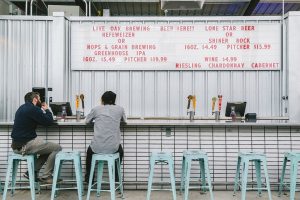Simply keeping shelves stocked in a nicely designed store is no longer enough. Next-gen consumers want – and are coming to expect – a place where they can not only purchase products, but can receive a memorable experience.
FEAR OF MISSING OUT
When it comes to choosing where to spend money, more than three-quarters of millennials (born roughly between 1982 and 2000) opt to spend on an experience over a material item, according to a recent study by Harris Poll (Rochester, N.Y.), and nearly 70 percent of the millennials surveyed reported experiencing FOMO (aka a fear of missing out).
Fully embracing a new era of experience culture, some retailers have built flagships solely dedicated to the notion. This past February, Samsung Electronics America Inc. (Ridgefield Park, N.J.) opened Samsung 837 in New York. The three-story “experience lab” is a digital playground featuring immersive floor-to-ceiling digital screens, auditorium seating for live performances and film screenings, meeting spaces for workshops and tutorials, a technical support and service center, and plenty of electronics on hand for tech junkies and novices alike to test out in person.
Samsung 837 / Courtesy of Samsung 837, New York
The difference here from other experiential stores? For starters, there’s no merchandise for sale.
“Creating a flagship without retail might sound like a crazy idea, but consumers today are seeking interactions and experiences rather than transactions,” says Zach Overton, vp and general manager of Samsung 837. “We’re giving our guests the opportunity to learn how technology can enhance their creativity, without the pressure to purchase that’s involved in a traditional retail store … it reflects how many modern brands are shifting their approach to reach today’s digital consumer.”
While a dedicated showroom is not a fit for all retailers, many will find ways to bring “experiential” into at least some of their formats, says Al Sambar, managing partner, retail and consumer group, Kurt Salmon (Atlanta). “Traditional retailers are experimenting with which parts of this experience should be rolled out to which parts of their banners, whether it’s interactive retail, custom or made-to-order … [part of the store] will definitely be an interactive show space.”
SOCIAL SOCIETY
Growing up with social media, millennials may have been the first generation to make it part of their everyday lives – in fact, according to a 2015 Deloitte (New York) survey, 60 percent of millennials (ages 19 to 32) value their time interacting with friends on social media sites as much as their time spent with friends in person – but they’re not the only ones taking to the Internet to share their points of view. The same survey reports that nearly 60 percent of all U.S. consumers check their social networks on a daily basis.
“The core of retail is still a person purchasing something they desire from someone they trust; fundamentally, that hasn’t changed,” says Sambar, but who they trust has. “In the old days, that core influencer might have been your corner market,” he says, but now, it may be someone on social media. “We have people that we trust around our purchase decisions now that we would not have had 10 years ago, and that world of trusted influencers is only growing broader.”
The beauty sector of retail, in particular, has been impacted significantly by this shift. To adapt, Sephora (Paris) has begun rolling out a new in-store educational concept, called its T.I.P. Workshop, where customers can convene for live beauty tutorials, either in person or via web streaming. The lines between the physical store and the world of online sharing are blurred by mirrors embedded with digital screens where shoppers can try out Sephora products along with the video tutorial they’re watching.
Sephora’s T.I.P. Workshop / Photography: Anton Van Der Uden, Amsterdam
The store also incorporates a digital “beauty board” where Sephora’s online community can live-share images of themselves wearing the makeup and offer reviews and recommendations on how to use the products.
“Everything’s about peer-to-peer,” says George Gottl, ceo of Uxus (Amsterdam), the design agency that helped implement this new concept for Sephora. “Social media influencers are playing a very large role in the beauty industry right now.”
The big dilemma for retailers is how they can compete in the social sphere, says Sambar. “Whoever has the content wins, so you’ve got to race to get that content delivered through mediums that emotionally connect with your customers.” And retailers are doing this by hiring bloggers and influencers with a following on social media to do just that.
“People want to see people looking like them, rather than a model, because a model is really unattainable,” says Gottl. “With those recommendations, you’re more likely to go and follow that than a commercial telling you what’s good, even though the influencers are now being paid and sponsored by brands.”
While many brands have created affiliate networks to promote their products, not all have been totally successful: Lord & Taylor (New York) was cited by the U.S. Federal Trade Commission in March 2015 for its lack of transparency in its methods, in which it paid 50 online influencers between $1000 and $4000 per post to promote one of its garments, without requiring that they include a paid promotional disclaimer. The suit was settled this past March on grounds that its future paid social media promotions would be clearly and conspicuously disclosed by all of its “influencers.”
“Lord & Taylor needs to be straight with consumers in its online marketing campaigns,” said Jessica Rich, director of the FTC’s Bureau of Consumer Protection, in a statement released by the organization. “Consumers have the right to know when they’re looking at paid advertising.”
| SOUNDING BOARD
We consulted with our Editorial Advisory Board to get the scoop on current
top-of-mind issues for retailers and design firms.
Here’s what they had to say: |
 |
The outlook for the future of retail?
“People will still like going to shop, but the brands need to be focused on the customer and [their] needs and the rewards for the shopping experience – instant gratification!”
–Tom Beebe, vp creative director, W Diamond Group |
 |
Why is omnichannel still important to retailers?
“Those companies who are still saying things like, ‘Our stores’ business is tough, but online is great,’ are those companies that will not be here for the long-term … If you don’t look at all channels in a holistic way, you are not listening to the customer.”
–Steven Derwoed, svp, store design and merchandising, Macy’s |
 |
What are the biggest challenges in designing retail with millennial/Gen Z customers in mind?
“They want spaces and products to reflect what they believe in, and are highly aware of social causes. It will be challenging for retailers who do not want to be highly transparent in their operations and store design.”
–Faith Bartrug, founder, Faith Bartrug Design |
 |
What excites you most about a potential design/visual merchandising candidate?
“A grounded blend of aspirational thinking that is also firmly rooted in a practical mentality. Someone who likes to question things, but knows retail success comes from an ability to program and implement things.”
–Paul Loux, svp of store design, Sephora |
 |
What are the major opportunities in retail?
“Experiential environments are going to become more [of] a trend – a florist, a bakery, a coffee shop, a bookstore – whatever draws in and keeps customers in your environment longer and [gets them] talking about it to all of their friends.”
–Bevan Bloemendaal, vp global environments and creative services, Timberland |
 |
What major challenges (besides online competition) are at the forefront for retailers?
“Increased competition with smaller start-up retail brands, which tend to connect with a specific customer segment that appreciates differentiation, localization and customization.”
–Robyn Novak, vp, creative managing director, FRCH Design Worldwide |
 |
How important is proving ROI on in-store technology?
“It is crucial. We are working with our clients to measure all design implementations. With well-developed digital solutions, you can track conversions and sales or engagement directly. It’s the number one reason and benefit of digital.”
–Peter Burgoyne, creative director, Dash Design |
A FOODIE CULTURE
While the U.S. may not have a deep-rooted history in food culture, that hasn’t stopped Americans from adopting a love affair with cuisine in recent years, explains Melissa Abbott, vp of culinary insights, The Hartman Group (Bellevue, Wash.).
“We’re eating a meal and [finding] ourselves already talking about what we’ll be having at the next meal,” she says. “We used to approach food in a very systematic way … as a way of getting the workforce going, and that was a result of the Industrial Revolution. Now we love food, we want to talk about it, we want to watch people make it – [now] it’s a hobby.”
Much like millennials’ willingness to devote a larger portion of their income to experiences, rather than material goods, many more of them are dining out on a regular basis than other generations. According to a 2015 Nielsen (New York) survey, nearly 60 percent of millennials eat out at least once a week (twice as much as their baby boomer counterparts), and 30 percent eat out three or more times per week.
Taking notice of this trend, and in an unexpected move, Urban Outfitters (Philadelphia) acquired its hometown’s Pizzeria Vetri last fall with plans to include the artisan pizza shop in its stores.
In November, the retailer introduced the pizzeria in one of its first multi-use stores, called Space 24 Twenty, which also includes Symon’s Burger Joint (shown below). The Austin, Texas, store is a combination of an outdoor live music venue, restaurant, craft beer bar and traditional retail space. It also includes local merchants in its pop-up marketplaces. A match for the city’s live music and indie retail culture, it also appeals to its University of Texas student demographic.
Symon’s Burger Joint, Space 24 Twenty, Austin, Texas / Photography: Driely Viera, Philadelphia
“Urban Outfitters knows that food culture is a hot thing for consumers [right now],” says Abbott. “If it had been The Gap, I may have been a little more concerned about that decision, but it seems that Urban has its finger on the pulse in terms of what’s going on in American culture.”
For Samsung 837, incorporating live cooking demonstrations in its “smart kitchen,” as well as a café, added to its overall “come to relax” experience: “This is the new ‘third space’ – one, work; two, home; three, hangout,” Overton explains. “Having a hub like a café helps achieve that.”
If a retailer is interested in adding an in-store dining or café element, Abbott explains, it must fit their brand – already having an aspirational lifestyle element is important – and they need to hire the right people to develop the concept. “The ones behind the vision have to be really passionate about food,” she says. “That is, above all, the key for success.”
While retailers may struggle to find a place for these particular experiential elements within their brands, most important is that they listen to the consumer and innovate to create next-gen stores for the next-gen shopper.
To read last year’s State of the Industry Report, click here.
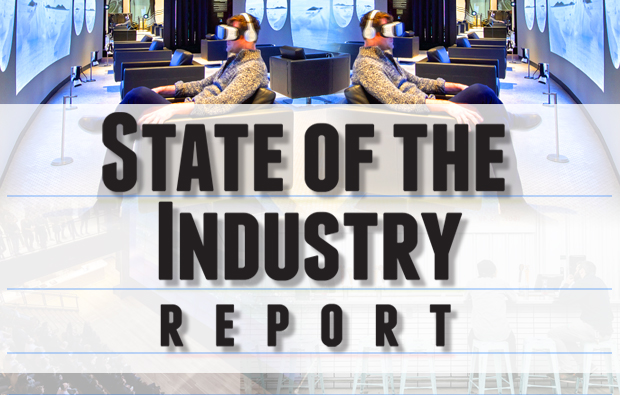

 Headlines1 week ago
Headlines1 week ago
 Headlines1 week ago
Headlines1 week ago
 Headlines1 week ago
Headlines1 week ago
 Designer Dozen2 weeks ago
Designer Dozen2 weeks ago
 Headlines6 days ago
Headlines6 days ago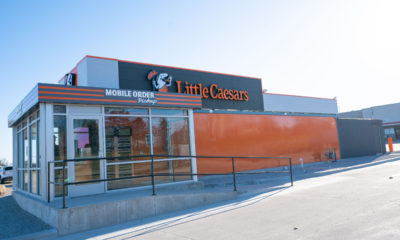
 Headlines2 weeks ago
Headlines2 weeks ago
 Headlines3 days ago
Headlines3 days ago







